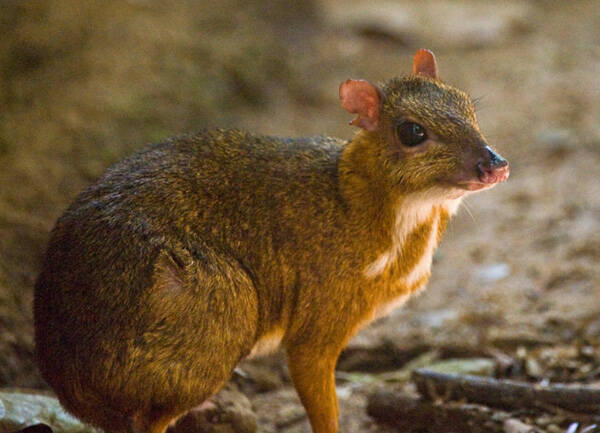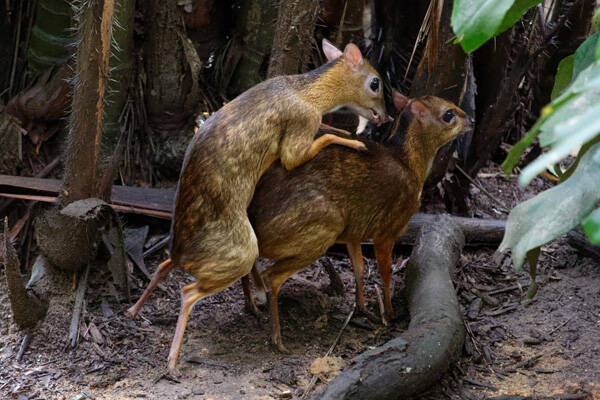Tragulus napu
IUCN
LCBasic Information
Scientific classification
- name:Tragulus napu
- Scientific Name:Tragulus napu,Greater Oriental Chevrotain、Balabac Chevrotain、Greater Indo-Malayan Chevrotain、Greater Mousedeer,Larger Malay Chevrotain,Larger Mousedeer,Napu,Chevrotain napu, Grand tragul malais, Napoh
- Outline:Ungulata
- Family:Artiodactyls Tragopanidae Tragopan
Vital signs
- length:42.5-68cm
- Weight:3.5-4.5kg
- lifetime:14-16years
Feature
The fur is orange-brown, with a grayish-white appearance due to a black stripe running down each hair.
Distribution and Habitat
Distributed in Brunei, Indonesia (Kalimantan and Sumatra), Malaysia (Sabah, Peninsular Malaysia, Sarawak), Myanmar, Singapore and Thailand.
Always lives near water, preferring to live in dense forests. 37-312 individuals per square kilometer. Populations in primary forests have an average range of 7 hectares; in suboptimal habitats such as cleared forests, the range is much larger, averaging 19 hectares. The species shows a preference for mature forests, although it also lives in secondary forests and plantations.
Appearance
The Greater Mouse Deer is a very small ungulate, with a head-body length of 42.5–68 cm, a shoulder height of 30–35 cm, a tail length of 6–10 cm, and an adult weight of 3.5–4.5 kg. It is humped, with very slender legs. The species varies greatly in coloration, which has led to different descriptions of many of the subspecies. In general, the fur is orange-brown, with a grayish-white appearance due to a black band running down each hair. The extent of this black band (larger or smaller) causes some populations, especially those on smaller islands, to have very dark or very red fur. The belly from the front legs to under the tail is white, with a dark stripe down the middle. The lower jaw is similarly white. The throat is usually marked with five white bands; two of these extend from the edge of the chin and run parallel to another pair of bands down the throat. The fifth central band or wedge on the throat may or may not be connected to these other bands. The forehead is often dark, with
Details
The Greater Mousedeer (scientific name: Tragulus napu) is called Greater Oriental Chevrotain, Balabac Chevrotain, Greater Indo-Malayan Chevrotain, Greater Mousedeer, Larger Malay Chevrotain, Larger Mousedeer, Napu in English, Chevrotain napu, Grand tragul malais in French, and Napoh in Malay. There are 20 subspecies.

"Tragos" means "goat" in Greek, and -ulus means "small" in Latin. Napu is the local name, which comes from the Malay word "napuh". The name "mouse-deer" refers to its small size and does not mean that it is a true deer. It is called "greater" because it is larger than other species in the genus Tragulus.
Both male and female giant mouse deer are territorial and have a strong sense of territory, with males marking their small but permanent territories with feces, urine and secretions from the submandibular gland. Giant mouse deer are docile but very alert, and males will slap the ground with their hooves at a rate of 4 times per second when harassed, excited or angry. Sometimes, males have been photographed standing on only one foot, for unknown reasons. Females tend to stay in their own territories, while males move around and usually do not stay in the same place for more than a year.
Giant mouse deer are very solitary creatures, except during the breeding season, and are usually seen alone, occasionally in pairs (male and female or female and calf) or rarely in groups of three. They are nocturnal animals with very unique activity and resting patterns. As they move back and forth through the dense forests, they trample trails. Due to the solitary nature of this species, they do not have a strict hierarchy, and fighting between males is a short, grappling exchange of sharp canine teeth. Males have a large gland on their jaws that they rub against the females to see if they are ready to mate. When the females are not ready, the males simply walk away.
Mouse deer are usually active at night, with the most activity between 04:00-10:00 and 16:00-00:00. They are a shy and reactive species. When slightly startled by strange noises, they will stay put, usually raising one leg and watching until the danger has passed. When in this state of high alert, the hind feet may be stamped to produce a drumming sound. If startled, these mouse deer will flee at explosive speeds. This species is a good swimmer and may retreat back into the water if threatened. The glands above the chin are used by both sexes to mark objects and other giant mouse deer, with males displaying more marking behavior than females. Vocalizations include a range of squeaks and aggressive growls.
In the wild, giant mouse deer feed on fallen fruits and berries, aquatic plants, leaves, buds, shrubs, and grasses. At the Smithsonian's National Zoo, giant mouse deer eat grass, alfalfa, kale, carrots, sweet potatoes, and banana peels.

The mouse deer breeds year-round, and females spend most of their adult lives pregnant. The estrus cycle is about 14 days, and the gestation period is 152-155 days. They will breed again within a few hours after the birth of the young. Usually give birth once a year, with only one offspring born at a time (twins are very rare), and the newborn weighs 225-380 grams. Offspring are born well developed and can stand and be fully active 30 minutes after birth. The young are "hidden" by their mother in secluded areas and nursed. Females have a unique nursing posture, which is performed while standing and raising one hind leg. The young are weaned at 2-3 months of age, reaching adult size at 5-6 months of age, and the tusk-like canines of young males can be seen at 10 months. Females reach sexual maturity as low as 4.5 months, and males at 7 months of age. Lifespan is up to 14 years, with a maximum of 16 years in captivity.
Hunting and habitat loss occur at high levels throughout almost the entire range of the giant mouse deer, but the species is said to be relatively resilient. However, data to support this assessment are scarce, especially because most key studies have not identified the giant mouse deer species in the Sundae area. Therefore, while it is clear that the genus remains widespread and common in the face of these threats. And there is reasonable evidence that they are not very adaptable to forest degradation. However, assuming that most species above 100 m in Borneo are greater mouse deer rather than lesser mouse deer, Borneo at least retains a significant population. Greater mouse deer are extinct in Singapore.
In Kerinci-Seblat National Park, Sumatra, poaching pressure for snare ungulates was greatest for deer and lowest for greater mouse deer. Greater mouse deer are scarce in areas of higher human hunting in Bukit Barisan Selatan National Park, Sumatra. The effects of hunting on mouse deer (irrespective of species) in two states of Malaysian Borneo (Sarawak and Sabah) were described through a long-term hunting study from February 1993 to June 1995. They constituted 8-9% of the animals killed. It is not possible to directly or index-measure the density of the mouse deer at these sites to determine the impact of this intensive hunting on the mouse deer. The mouse deer is one of the favorite wild meats of the residents of the Sarawak plantation area in Bintulu, Sarawak, second only to sambar and wild boar.
Listed in the IUCN Red List of Threatened Species in 2014 ver3.1 - Least Concern (LC).
Protect wildlife and eliminate game.
Maintaining ecological balance is everyone's responsibility!








